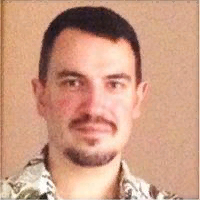International Journal of Engineering and Manufacturing (IJEM)
IJEM Vol. 8, No. 6, 8 Nov. 2018
Cover page and Table of Contents: PDF (size: 854KB)
Spiral Flows at the Cardiovascular System as the Experimental Base of New Cardiac-gadgets Design
Full Text (PDF, 854KB), PP.1-12
Views: 0 Downloads: 0
Author(s)
Index Terms
Virtual "Revival", cardiac-gadgets, spiral laying of vessels smooth muscle, neural networks modeling, mechanodynamics
Abstract
The results of studies of the functional mechanodynamics of the arteries of the cardiovascular system are presented. Methods of mathematical neural computer modeling, developed by the authors, were reproduced the features of blood flow in statics and dynamics, taking into account the spiral laying of vessels smooth muscle with the transfer of its relief through a thin endothelial membrane lining the inner surface. It is shown that the the nature of the blood flow significantly differs with the both quantitative and qualitative characteristics from the blood flow without regard to the spiral endothelial relief repeating helical laying of smooth shell. The developed methods of neurocomputer modeling allow reconstruct and detect events to recreate the picture of the functioning of living bio tissue. Based on the obtained results and neural networks modeling, a new paradigm for the design of implantable cardiac-gadgets purposed.
Cite This Paper
A.V. Savelyev, I.V. Stepanyan,"Spiral Flows at the Cardiovascular System as the Experimental Base of New Cardiac-gadgets Design", International Journal of Engineering and Manufacturing(IJEM), Vol.8, No.6, pp.1-12, 2018. DOI: 10.5815/ijem.2018.06.01
Reference
[1]Folkow, B. & Neil E. 1971. Circulation. Oxford University Press, New York, London, Toronto.
[2]T. J. Pedley 1980. The Fluid Mechanics of Large Blood Vessels (Cambridge Monographs on Mechanics).
[3]Bakusov LM Some of the models and methods of hemodynamic wave. Ufa: AIM. 1992. 50 pp.
[4]Leshchev SV Synergistic measurement neuro-platform: continual interfaces // Biomedical electronics. Number 2016. 4. pp.71-72.
[5]Kolushov VV, Saveliev AV Supervisualisation of biomehanodinamics of highly complex systems // Biomedical electronics. Number 4. 2015. pp 37-39.
[6]Yavelov IS, Stepanyan IV, Rochagov AV, Fedyanin VI, Zholobov AV (2017) Perspective Questions of Mechanopulsography. J Biomed Eng Med Devic 2: 125 DOI: 10.4172 / 2475-7586.1000125
[7]Yavelov IS, MY Izrailovich, Ehrlich BM Rochagov AV Modeling the effect of the massage effect on the increase in local blood flow. // Biomedical electronics. Number 2017. 3. S. 43-47.
[8]Nakayama Y, Furukoshi M, Terazawa T, Iwai R. Development of long in vivo tissue-engineered "Biotube" vascular grafts. Biomaterials. 2018; 185:232-239.
[9]Yang Y, Meyer CH, Epstein FH, Kramer CM, Salerno M. Whole-Heart Spiral Simultaneous Multi-Slice First-Pass Myocardial Perfusion Imaging. Magn Reson Med. 2018.
[10]Yahyaie M, Tarokh MJ, Mahmoodyar MA. Use of Internet of Things to Provide a New Model for Remote Heart Attack Prediction. Telemed J E Health. 2018.
[11]Yıldırım Ö, Pławiak P, Tan RS, Acharya UR. Arrhythmia detection using deep convolutional neural network with long duration ECG signals. Comput Biol Med. 2018.
[12]Meyer A, Zverinski D, Pfahringer B, et al. Machine learning for real-time prediction of complications in critical care: a retrospective study. Lancet Respir Med. 2018.
[13]He R, Wang K, Zhao N, et al. Automatic Detection of Atrial Fibrillation Based on Continuous Wavelet Transform and 2D Convolutional Neural Networks. Front Physiol. 2018; 9:1206.
[14]Iffrig E, Wilson JS, Zhong X, Oshinski JN. Demonstration of circumferential heterogeneity in displacement and strain in the abdominal aortic wall by spiral cine DENSE MRI. J Magn Reson Imaging. 2018.
[15]Sander B. MR-Grundlagen E-print: http://www.mrx.de/mrpraxis/mrgrund.html
[16]White DN The early development of neurosonology: I. echoencephalography in adults // Ultrasound in Medicine and Biology. 1992. V.18. # 2. P.115-165.
[17]Saveliev A.V. The law of conservation of complexity and its application in problems of modeling non-equilibrium systems. // Simulation of non-equilibrium systems. Krasnoyarsk. 1998. p. 100-101.
[18]Saveliev A.V. Towards a general theory of neural networks. On the issue of complexity // Neurocomputers: development and application. Radio engineering, Moscow. 2006. № 4-5. Pp. 4-14.
[19]Kolushov VV, Saveliev AV The methodology of individual collective modeling neural biovozbudimosti as a new paradigm neurocomputing // Neurocomputers: development and application. 2010. 8. S.25-34 number, http://www.ec-ai.ru/default.asp?article=3.
[20]Kolushov VV Application of neural network algorithms in the realization of expert modeling technology cardiodynamic // In: Neuroinformatics-2004: Proceedings of the VI All-Russia. NTK. M.: MEPHI, 2004. V.2.
[21]Kositsin NSThe microstructure of dendrites and aksodendriticheskih connections in the central nervous system. M.: Nauka. 1976. 199 p.
[22]Shotton DM, Heuser JE, Reese BF, Reese TS Postsynaptic membrane folds of the frog neuromuscular junction visualized by scanning electron microscopy // Neuroscience. 1979. V.4. # 3, P.427-435.
[23]Kerlov IV Art of 3D-animation and special effects. (Per.s Engl. Smolina EV). M.: OOO "Top", 2004. 480 p.
[24]Ratner P. Three-dimensional modeling and animation of man. M: Williams. 2005. 272 p.
[25]Saveliev A.V. Neurological aspects of cellular neuromathematics // Artificial Intelligence. NAS of Ukraine, Donetsk. 2008. No. 4. P. 612-623.
[26]Saveliev A.V. Neurophysics of the brain and neuro-modeling: diffusion-synergistic aspects of volumetric neurotransmitting // Journal of Open Systems Evolution. Kazakhstan, Almaty. 2008. No. 1. V. 9 P. 93-101.
[27]Patent DE 618 610 C. Wasserfuehrung / Schauberger V. 1935-09-12.
[28]Patent AT196680 B. Rohrleitung für flüssige und gasförmige Medien / Schauberger V. 1958-03-25.
[29]Bryantsev IS, Kolushov VV, Saveliev AV "Virtual revival" of neural information objects // Neurocomputers: development and application. 2016. №5. pp. 21-23.
[30]Mishustin IA, Preobrazhensky NB, Zhdanov A.A., Stepanyan I.V. Hardware implementation of a neuron-like network with the ability to recognize noisy images // Neurocomputers: development, application. 2018. № 6. S. 19-25.
[31]Petoukhov S.V., Svirin V.I., Khazina L.V. Bionics of Spiral Structures. – Journal of Machinery Manufacture and Reliability, 2015, Vol. 44, No. 3, pp. 249–253. © Allerton Press, Inc., 2015.

